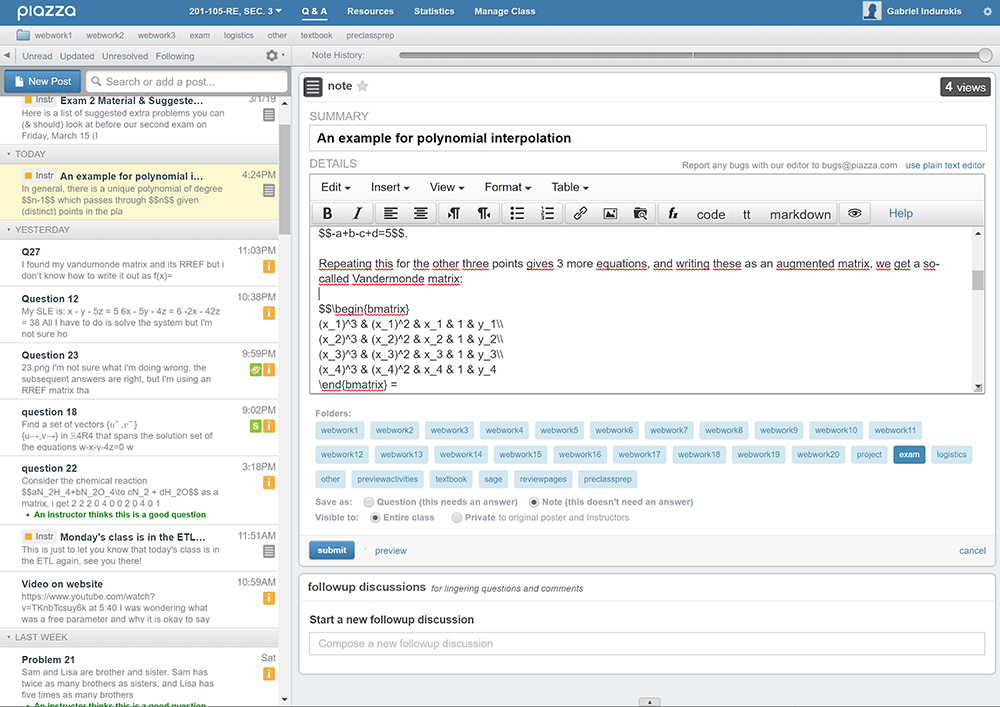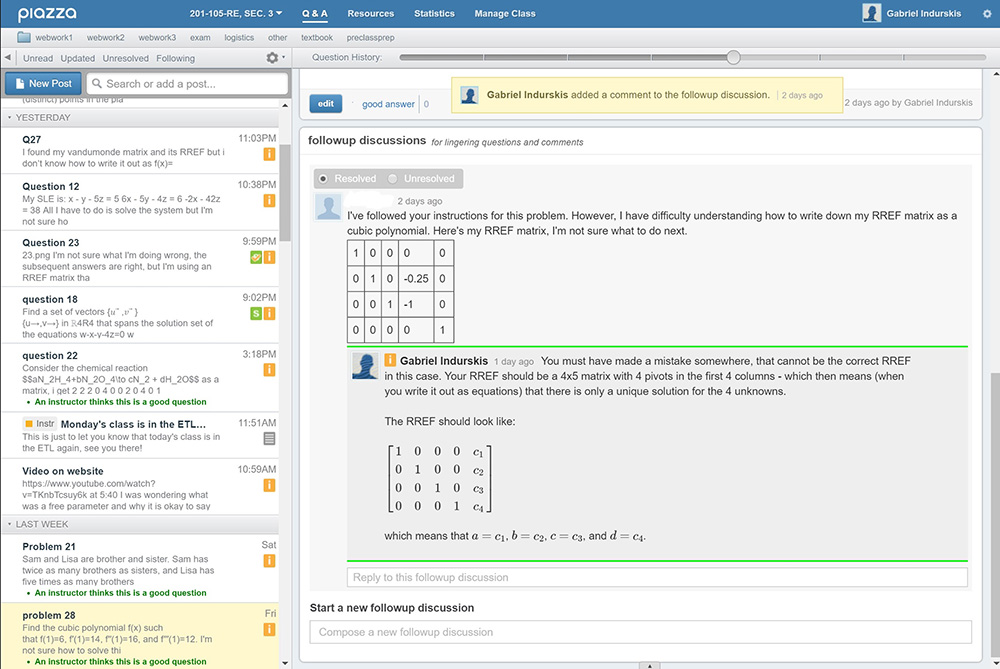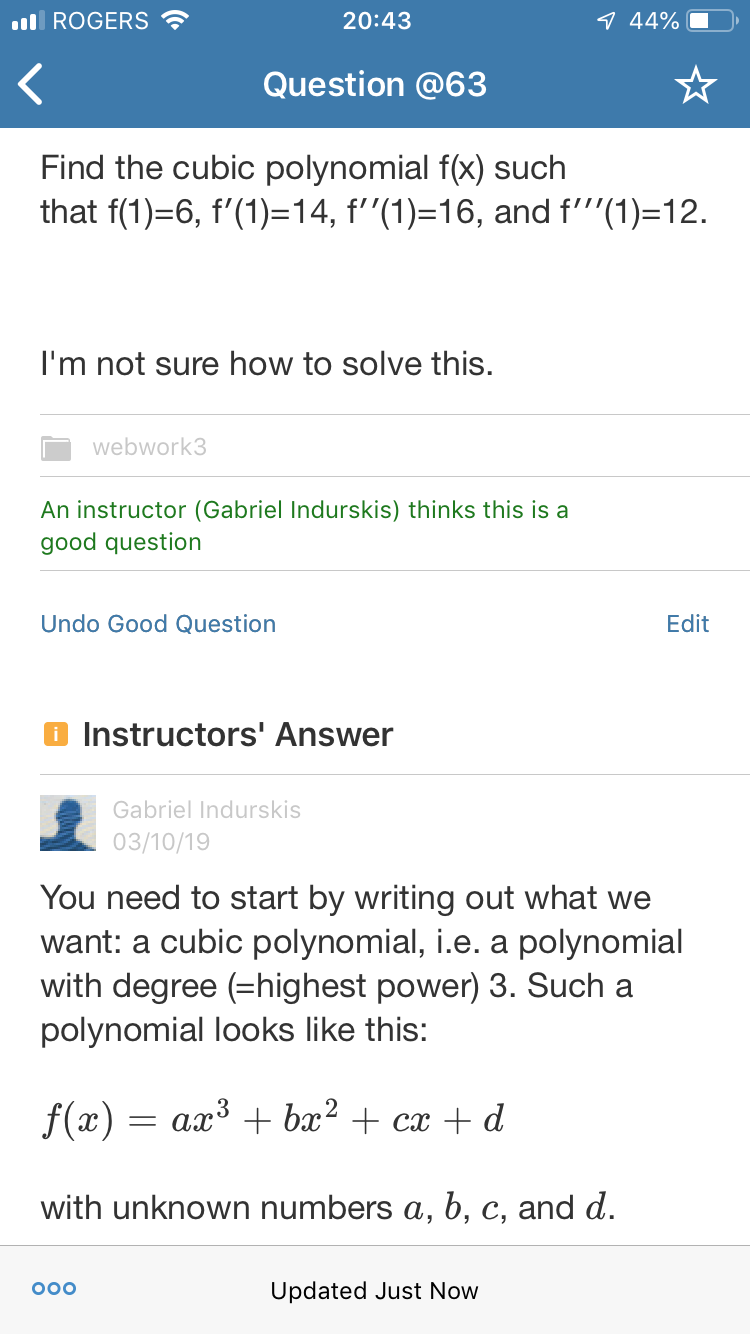Managing Student Questions with the Piazza Q&A Platform
Author’s Note
This Real Life Story was written with the collaboration of Ryan W. Moon, Editor, Profweb.
As a busy teacher, I am always on the lookout for technologies that help me to most efficiently use my time. For the last 2 years I have adopted the Piazza.com Q&A platform to help me manage material-related student questions in all my CEGEP mathematics courses (Calculus, Linear Algebra, Statistics, etc.), rather than using e-mail or MIO. It helps me to avoid answering the same question over and over and empowers students to answer questions among themselves.
Piazza (from the Italian word for plaza, a common city square where people can come together to share knowledge) is a social learning Q&A platform for higher education where you can answer students’ questions once for all students to see. Every question has an “official” instructors’ answer as well as a collaborative students’ answer (similar to a Wiki), which encourages students to interact with and help each other. Because of the Wiki-style, the latest state of the discussion is immediately visible for the students, instead of forcing them to scroll through a long discussion thread. This also enables students (and instructors) to edit/improve/correct their questions after they have already been posted.
An overview of Piazza and its main features
When I first started using Piazza, I looked into some of the ethical considerations for the platform and was reassured: The company is very transparent about its privacy policies (the platform is compliant with typical confidentiality agreements, but holds itself also accountable to the US FERPA standard) and its business model: They promise that their service “is and will stay free to instructors and students”, which is realized through funding provided through an opt-in career opportunities network (the “Piazza Network”).
To encourage students to use Piazza, I clearly announce in my course outline (and in person in the first class) for each course that I will not be accepting questions about course material through e-mail or MIO. To further sell students on using the platform, I usually also point out that when they are burning the midnight oil studying before an exam, they would not usually be able to expect an immediate answer by me to their questions. However, as there are often other students studying and using the platform at the same time as them, their chances of getting immediate help from their peers during cramming sessions are high! Another aspect I usually also point out is that the system works very well with scientific notation (as opposed to almost all other forms of communication), which makes it much easier for them to understand the mathematical content in my answers.
Setting Up a Course on Piazza
The process of creating a new course on Piazza at the beginning of the semester is very straightforward and automated for the most part. One simply has to fill in a title, course number, and institution, and configure how students register for the course: For me, the easiest method ended up being the use of a sign-up link and code, which I include within my course outline. I sometimes even let students register on their phones during the first class of my course.
Each course is, by default, set up with a standard collection of “folders” (called labels or keywords on other sites), which are used to categorize each question or post on the site, for example “homework1”, “homework2”, “exam1”, “logistics”, etc. I usually just modify these very slightly for my needs (for example, I change “homework” to “webwork”, since I use this electronic homework system for my courses). Students have to choose at least one of these keywords in order to submit the post. This is really useful since students looking for help on a specific topic won’t have to search through pages and pages of discussion to discover the latest, closest-to-the-truth answers. Instead, all posts can be very easily filtered by these keywords.
For every new class, Piazza automatically creates a post that explains to students how they can use the platform optimally. Students can install a Piazza app on their smartphone and get immediate notifications (available for Android and iOS) when someone has responded to their questions.
Question Management
New posts are in the form of a question or a note. All posts can be written using a rich-text editor that supports modern web standards, whether you are using a computer or a smartphone, and also allows to embed images or other documents when needed: especially in mathematics, this can be very useful, as students can include a picture of their handwritten work instead of retyping it). The editor also includes an easy-to-use formula editor, but more advanced users can instead choose to directly use the scientific typesetting language LaTeX – a real advantage for science, physics and math teachers. For quickly creating structured text, one can also directly use Markdown syntax (which is easy to learn and highly recommended). For computer-science related material, one can also easily typeset code segments with syntax highlighting. All of this also makes it easier for me to reuse material I have already created outside of the platform (for example exercise solutions, or explanations to recurring tricky topics).
Duplicate questions can be easily marked as such, avoiding repetition. There are different possibilities for the status of a question, like unread, updated, unresolved that help the teacher easily filter the questions and facilitate their workflow.
The students can provide an answer as well as the instructor and these responses can be discussed in a forum style in so-called “follow-up discussions” below each post (which in turn get an “unresolved” or “resolved” status attached). Teacher answers are tagged with an orange mark, while a green mark is assigned to student responses. The teacher can easily endorse a student response by assigning the status of “instructor approved” with a simple click.
Similar to a Wiki, the Piazza platform keeps track of all changes to any post, and there is a slider for the question history that lets you jog between the versions.
Collaborating with Peers
Some students may be too shy to ask questions in class or visit me during office hours. Piazza allows them to think about their questions before posting them, and reduce their general stress level.
One of the reasons I like Piazza is that it encourages peer-to-peer transfer of knowledge by sharing and endorsing good questions and answers. I really enjoy it when a student who has posted a question thanks the other students who have taken the time to answer this question.
Over the last 2 years, I’ve learned to step back and not to answer questions right away, leaving the opportunity for other students to answer the questions. After some time has passed (usually a couple of hours) I can evaluate whether to declare a student answer as “instructor-approved” (while adding some additional feedback), or I can answer any unresolved questions, which are easy to identify in the overview, due to an intelligent highlighting system.
Facilitating Workflow
Piazza is a huge time-saver for me. Instead of answering a question 30 times, I only have to answer it once or endorse a student answer to the question. Instead of having to use separate tools, I can directly and quickly enter mathematical notation using LaTeX, which is instantly rendered into an easily readable form. The ability to directly write in Markdown syntax is also a great advantage for me, as it allows me to write longer posts in a well-structured form in a fraction of the time it would take using more “traditional” editing tools.
For those who are interested in these kind of things, there are interesting statistics available for each course, such as the average amount of time between the posting of a question and its answer. One can also see detailed statistics about students’ active and passive participation through stats on the number of questions asked/answered/viewed and marked as “good” by an instructor.
I hope other teachers give the platform a try, as it has helped me manage my time more wisely and provides a new way for students to help each other and take charge of an aspect of their learning. A good starting point is the page at: https://piazza.com/toolkit





